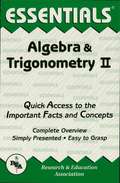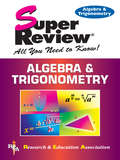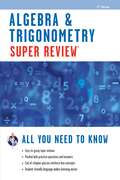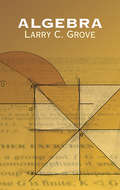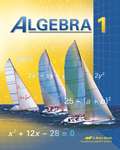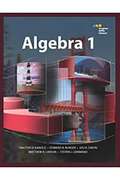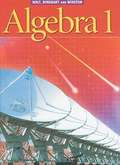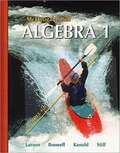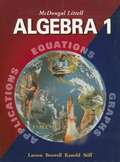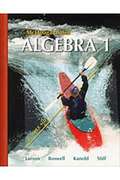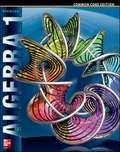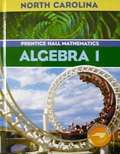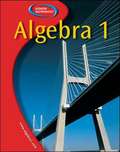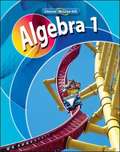- Table View
- List View
Algebra & Trigonometry I Essentials
by Editors of REAREA's Essentials provide quick and easy access to critical information in a variety of different fields, ranging from the most basic to the most advanced. As its name implies, these concise, comprehensive study guides summarize the essentials of the field covered. Essentials are helpful when preparing for exams, doing homework and will remain a lasting reference source for students, teachers, and professionals. Algebra & Trigonometry I includes sets and set operations, number systems and fundamental algebraic laws and operations, exponents and radicals, polynomials and rational expressions, equations, linear equations and systems of linear equations, inequalities, relations and functions, quadratic equations, equations of higher order, as well as ratio, proportion, and variation.
Algebra & Trigonometry Super Review (Super Reviews Study Guides)
by Editors of REAGet all you need to know with Super Reviews! Each Super Review is packed with in-depth, student-friendly topic reviews that fully explain everything about the subject. The Algebra and Trigonometry Super Review includes sets and set operations, number systems and fundamental algebraic laws and operations, exponents and radicals, polynomials and rational expressions, equations, linear equations and systems of linear equations, inequalities, relations and functions, quadratic equations, equations of higher order, ratios, proportions, and variations. Take the Super Review quizzes to see how much you've learned - and where you need more study. Makes an excellent study aid and textbook companion. Great for self-study! DETAILS - From cover to cover, each in-depth topic review is easy-to-follow and easy-to-grasp - Perfect when preparing for homework, quizzes, and exams! - Review questions after each topic that highlight and reinforce key areas and concepts - Student-friendly language for easy reading and comprehension - Includes quizzes that test your understanding of the subject.
Algebra & Trigonometry Super Review - 2nd Ed. (Super Reviews Study Guides)
by Editors of REAREA's Algebra and Trigonometry Super ReviewGet all you need to know with Super Reviews!2nd EditionREA's Algebra and Trigonometry Super Review contains an in-depth review that explains everything high school and college students need to know about the subject. Written in an easy-to-read format, this study guide is an excellent refresher and helps students grasp the important elements quickly and effectively.Our Algebra and Trigonometry Super Review can be used as a companion to high school and college textbooks, or as a handy resource for anyone who wants to improve their math skills and needs a fast review of the subject.Presented in a straightforward style, our review covers the material taught in a beginning-level algebra and trigonometry course, including: algebraic law and operations, exponents and radicals, equations, logarithms, trigonometry, complex numbers, and more. The book contains questions and answers to help reinforce what students learned from the review. Quizzes on each topic help students increase their knowledge and understanding and target areas where they need extra review and practice.
Algebra (Dover Books on Mathematics #Volume 110)
by Larry C. GroveThis graduate-level text is intended for initial courses in algebra that begin with first principles but proceed at a faster pace than undergraduate-level courses. It employs presentations and proofs that are accessible to students, and it provides numerous concrete examples.Exercises appear throughout the text, clarifying concepts as they arise; additional exercises, varying widely in difficulty, are included at the ends of the chapters. Subjects include groups, rings, fields and Galois theory, modules, and structure of rings and algebras. Further topics encompass infinite Abelian groups, transcendental field extensions, representations and characters of finite groups, Galois groups, and additional areas.Based on many years of classroom experience, this self-contained treatment breathes new life into abstract concepts.
Algebra 1
by AbekaAlgebra 1 is a practical textbook with many features to make your study of algebra interesting and successful.
Algebra 1
by Gilbert J. Cuevas Winters Gordon Staff Collins Publishers Staff Russell J. Foster Moore-Harris Rath William L. SwartWhy do I need to study algebra? When am I ever going to have to use algebra in the real world? Many people, not just algebra students, wonder why mathematics is important. Algebra 1 is designed to answer those questions through integration, applications, and connections.
Algebra 1
by Holt Winston RinehartThis book discusses in detail the important topics in Algebra and is meant to be used as text book in class.
Algebra 1
by McGraw-Hill Education Staff<p>The only program that supports the Common Core State Standards throughout four-years of high school mathematics with an unmatched depth of resources and adaptive technology that helps you differentiate instruction for every student. <p> <li>Connects students to math content with print, digital and interactive resources. <li>Prepares students to meet the rigorous Common Core Standards with aligned content and focus on Standards of Mathematical Practice. <li>Meets the needs of every student with resources that enable you to tailor your instruction at the classroom and individual level. <li>Assesses student mastery and achievement with dynamic, digital assessment and reporting. </li> </p>
Algebra 1 (Ak Peters Series)
by Dan Kennedy Sr. Randall Charles Allan Bellman Sadie Bragg William HandlinNORTH CAROLINA PRENTICE HALL MATHEMATICS ALGEBRA 1
Algebra 1 (Florida)
by Gilbert J. Cuevas Roger Day John A. CarterA flexible program with the solid content students need Glencoe Algebra 1strengthens student understanding and provides the tools students need to succeed--from the first day your students begin to learn the vocabulary of algebra until the day they take final exams and standardized tests.
Algebra 1 (Glencoe Mathematics)
by Berchie Holliday Gilbert J. Cuevas Roger Day John A. Carter Beatrice Moore-Harris Daniel Marks Ruth M. Casey Linda M. HayekFrom the first day your students begin to learn the vocabulary of algebra until the day they take final exams and standardized tests, these programs strengthen student understanding and provide the tools students need to succeed.
Algebra 1 (Grade #9)
by Berchie Holliday Gilbert J. Cuevas Beatrice LuchinAlgebra 1 is a key program in our vertically-aligned high school mathematics series developed to help all students achieve a better understanding of mathematics and improve their mathematics scores on today's high-stakes assessments.
Algebra 1 (Illinois)
by Ron Larson Laurie Boswell Lee Stiff Timothy D KanoldThe content of Algebra 1 is organized around families of functions, with special emphasis on linear and quadratic functions. As you study each family of functions, you will learn to represent them in multiple ways--as verbal descriptions, equations, tables, and graphs. You will also learn to model real-world situations using functions in order to solve problems arising from those situations.
Algebra 1 (McDougal Littell Mathematics)
by Ron Larson Laurie Boswell Lee Stiff Timothy D. KanoldMcDougal Littell Algebra 1 (McDougal Littell Mathematics) <p>2007th Edition
Algebra 1 (Missouri)
by Ron Larson Laurie Boswell Lee Stiff Timothy D. KanoldNIMAC-sourced textbook
